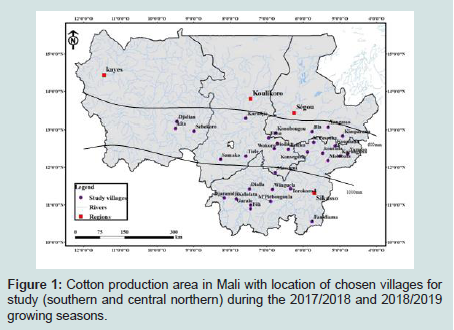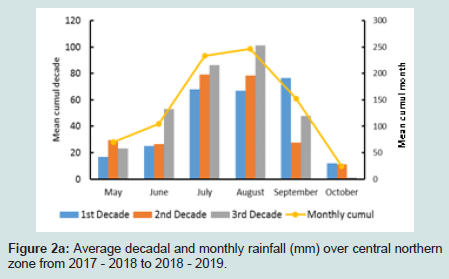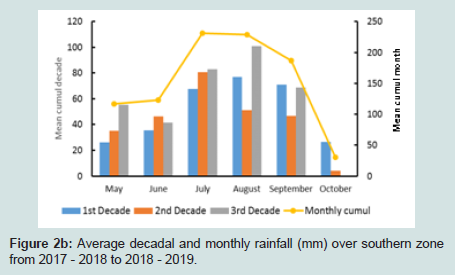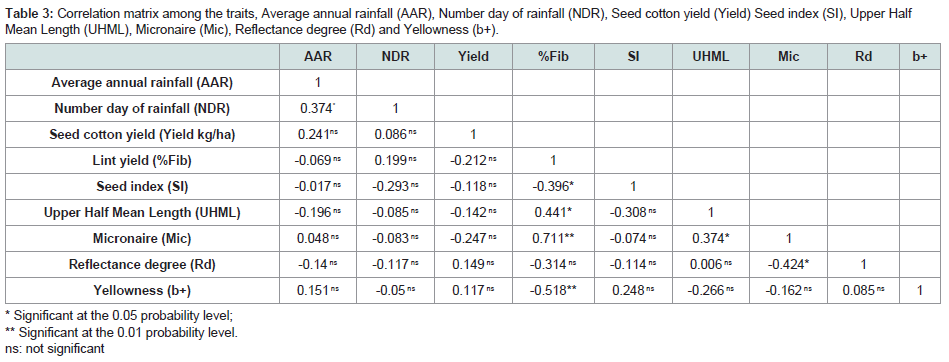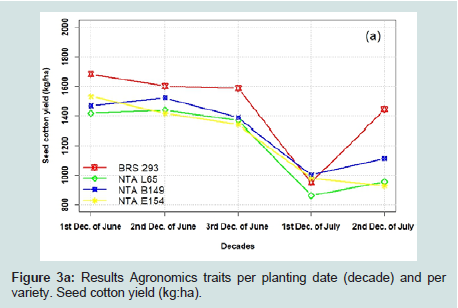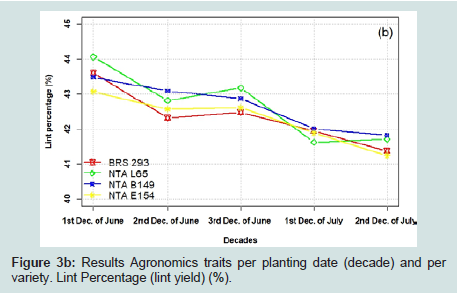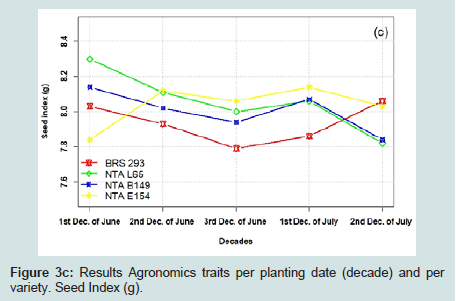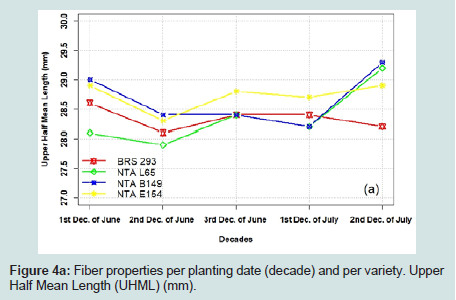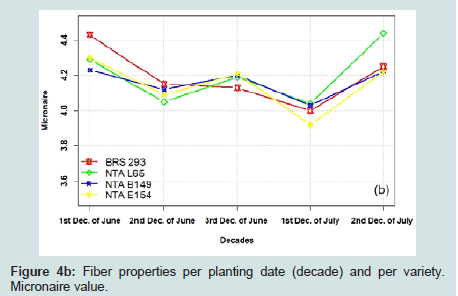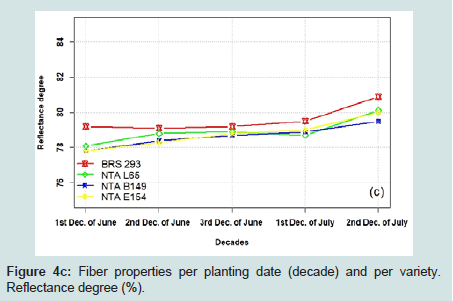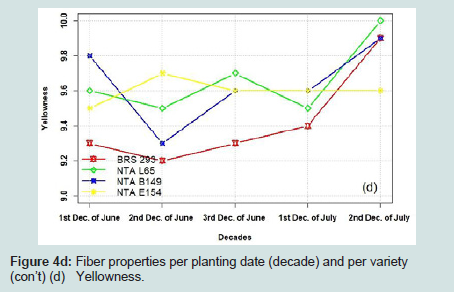Journal of Bioanalysis & Biostatistics
Download PDF
Research Article
Planting Date Effect on Yield and Fiber Properties in Some Cultivars and Promising Crosses of Cotton (Gossypium Hirsutum L.) in Mali
Kassambara EM1*, Sissoko S1,2, Diawara MO1,2, Teme N1 And Yattara AA1
1Institut d’Economie Rurale (IER), Mali
2Département d’Enseignement et de Recherche de Biologie ;
Université des Sciences des Techniques et des Technologies de
Bamako (USTTB), Mali
*Address for Correspondence: Kassambara EM, Programme coton Station de N’Tarla IER-Mali, Mali,
Tel: (+223) 21 76 46 14; E-mail.: kassambaraelhadj@yahoo.fr
Submission: 23 Septmber, 2019
Accepted: 28 October, 2019
Published: 31 October, 2019
Copyright: © 2019 Chang M, et al. This is an open access article
distributed under the Creative Commons Attribution License, which
permits unrestricted use, distribution, and reproduction in any medium,
provided the original work is properly cited.
Abstract
Cotton is the most important cash crops in Mali. It is a major
catalyst of economic development in rural areas.
Cotton is produced under rainfall conditions and is subjected to
fluctuating rainfall variability, drought, high temperature, moisture, soil
poverty in nutrients combined with the lack of innovative technologies,
and seed cotton yield price volatility. In Mali cotton is planted during
growing season so planting date depends on the beginning of rainfall.
In this study, the data from thirty four trials conducted in two vast
cotton-producing zones (Southern and central northern) of Mali during
two rainy seasons. Data were collected and analyzed to determine
the effect of planting date on yield, yield components and particular
fiber properties of four promising cotton genotypes. Five planting
decades were identified (planting occurred in 1st, 2nd, 3rd decade of
June and 1st, 2nd decade of July) in each year. Results indicated that
only seed cotton yield, lint percentage, fiber length, fiber fineness and
fiber whiteness were significantly affected by planting dates. On the
other hand, planting date did not affect significantly the seed index
and fiber quality traits such as yellowness. All four genotypes: BRS 293,
NTA L65, NTA B149 and NTA E154 used in the experiment produced
suitable seed cotton yield and yield attributes and acceptable lint
propriety for early sowing. For delaying sowing, the variety BRS 293 was
better and is suitable in Malian cotton producing area regardless of
the planting date.
Keywords
Cotton; Fiber; Planting date; Decade; Sowing; Early; Delaying; Late
Introduction
Cotton is the world’s most important fiber crop and the second
most important oil seed crop [1]. In West and Central Africa (WCA),
cotton represents the main source of income for 20 million people
and amounts to up to 60 percent of national export earnings. The
WCA region produces about 16% of the world’s cotton and is the
5th largest world exporter after the United States, China, India and
Uzbekistan [2].
Malian economy is based on agriculture, which occupies more
than 70% of its population. Mali’s population sustains itself on smallscale,
rainfall subsistence agriculture. Cotton, a rainfall and main
cash crop, allows around 40% of the rural population to dependent
on its production [3]. While rice and coarse grains (maize, millet and
sorghum) constitute the main food crops. Cereals represent more
than two-thirds of the country’s dietary energy supply. Mali is a net exporter of cotton and livestock and a net importer of rice [4].
Most smallholders in Mali’s cotton zones grow cotton. They earn
higher incomes and invest more in agriculture than smallholders
in other zones. These additional resources allow cotton farmers to
produce up to 70 percent more cereals per capita than non-cotton
farmers [5].
Cotton quality has different significances for farmers and
industry. For farmers, high cotton quality means more revenue and
for the industry, it means fewer losses. So it is important for farmers
to manage cotton fields for the best possible attainable quality.
It is important for the industry to acknowledge that there are
many uncontrollable factors affecting fiber quality. Fiber quality
differs among cotton fields, plants and bolls. Even in one seed
different fiber quality may be found. Fiber quality is under genetic
control, and cotton fields can be managed for best quality. However,
the weather has an important unpredictable effect on quality [2]. Fiber
length is largely influenced by variety, but the cotton plant’s exposure
to extreme temperatures, water stress, or nutrient deficiencies may
result in shorter fibers [6].
Mali is today the largest producer of cotton in Sub-Saharan
Africa. Mali’s cotton production for 2017/2018 is estimated at a
record 725,000 tones, up or 12% from last year’s (2016 - 2017) record
crop. Harvested area was estimated at a record 0.73 million hectares,
up 750,000 hectares or 11% from last year’s record area. Mali’s cotton
is planted from May to July and harvest is done from late October to
December [7].
Cotton production occurs in a vast zone of southern and central
northern of country, where each zone has its own characteristics. All
production is managed by a cotton ginning Mill Company belonging
to the “Compagnie Malienne de Developpement de Textile -CMDT)”.
The Sikasso region in southern Mali produces approximately 60% of Mali’s total cotton. Cropping conditions in Sikasso are average to
above-average from May through October.
Figure 1: Cotton production area in Mali with location of chosen villages for
study (southern and central northern) during the 2017/2018 and 2018/2019
growing seasons.
Mali’s cotton production record is attributed to increased planted
area resulting from strong prices and above-average yields due to
favorable weather.
Main constraints in cotton production in Mali are the lack of
innovative technologies, irrigation, and infrastructure of storage; that
combined with price volatility in addition to a very volatile rainfall
uncertainty during planting and harvest times [4].
The main objective of this study was to identify effects of planting
date on cotton seed yield and fiber quality.
Materials and Methods
Experimental site:
The study has covered two vast cotton-producing zones of Mali
during the 2017/2018 and 2018/2019 rainy seasons (Figure 1).The southern zone is located in the Sudanian zone. The average
annual rainfall is between 1000 mm and 1200 mm. The length of the
rainy season varies 5 to 6 month from May through October. Cotton
is planted from May to July and harvested from late October to
December [4]. The study was conducted in fourteen villages.
The central northern zone is located in the Sahelo-Sudanian zone.
Average annual rainfall ranges between 600 to 1000 mm per year. The
length of the rainy season varies between 4 to 5 month form June/July
to September/October. Cotton planted from June to July and harvest
is done from October to December [4]. In the central northern zone,
twenty selected villages conducted the experiments.
In all production area (southern and central northern) the cotton
production is carried out under rain-fed conditions.
The samples harvested seed cotton was collected from different
sites and sample seed cotton was ginned at ginning factories 20 sheets
of saw tooth of Agronomic Research Station of N’Tarla, IER Mali, to
separate the lint from the seed.
Genetic material was composed of four varieties. One variety is from
Brazil and other three are from Mali (Table 1). All these four genotypes
are in their last on farm test before going for Value of Cultivation Use (VCU) and release.
Methodologies
Experimental design:
Randomized Complete Block Design (RCBD) with two
replications (blocks) was used. Each genotype was planted in five
rows of 30 m length. Plant to plant and row to row distances were 30
and 80 cm, respectively. The center three rows of each five-row plot
were harvested by hand after cotton boll opened.The experimental design was implanted inside the farmer field
and was planted the same date with farmer field, receive the same
crop management (weed control, insect control and fertilizer apply)
as in the farmer own field.
Data recorded:
Data were collected on two main components: Agronomical and
cotton fiber technological characteristics.Agronomical characteristics:
They were composed of:• Planting dates: The planting dates of each site in 2017/2018 and
2018/2019 were recorded.
• Seed cotton yield (kg/ha): Seed cotton harvested from the
individual plots (three central rows) was weighted to determine yield
in kilogram per hectare (kg/ha).
• Lint yield (percent): Samples of seed cotton harvested from
individual plots were ginned using ginning machine of 20 sheets of
saw tooth without lint cleaning at the N’Tarla research station facility
to determine lint percentage (%) by using the following formula:
• S e e d Index (g): Seed index was determined as weight of 100
seeds in grams.
Fiber properties:
Four major fiber properties were analyzed in this study. They
were fiber length, fineness, reflectance degree and yellowness. These
properties depends on maturity which determines yarn tensility,
evenness, imperfections and hairiness [8]. For fiber properties characterization, the HVI techniques were used. A sample of 50 g
of lint was taken from the individual cotton plots for the analysis
of: upper half mean length (UHML); micronaire (Mic), reflectance
(+Rd), and yellowness (+b).
Figure 2a: Average decadal and monthly rainfall (mm) over central northern
zone from 2017 - 2018 to 2018 - 2019.
Figure 2b: Average decadal and monthly rainfall (mm) over southern zone
from 2017 - 2018 to 2018 - 2019.
• Upper Half Mean Length (mm):
The HVI upper half mean length (UHML) is the average length of
the longest 50% of fibers in a sample or bale [9]. This measurement is
used to place cotton into the five upland staple classes which are short
(<21.0 mm), medium (22.0 mm - 25.0 mm), medium-long (26.0 mm
- 28.0 mm), long (29.0 mm. - 34.0 mm), and Extra-Long Staple (ELS)
(>34.0 mm) [10].The importance of fiber length to textile processing is significant.
Longer fibers produce stronger yarns that allow for more valuable
end products. Longer fibers also enable higher spinning speeds.
• Micronaire (units):
Fiber micronaire (Mic) or fiber fineness is the indicator of fiber
maturity and fineness that depends on both fiber diameter and
secondary wall thickness. The rating of fineness of given fiber for
spinning are: very fine fiber (below 2.9); fine (2.9 - 3.7); medium (3.8 -
4.6); coarse fiber (4.7 - 5.5) and very coarse (5.6 and above) [11]. A low
micronaire fiber (<3.5) results in knots of broken fiber whereas high
micronaire (>4.9) will not convert into a bean shape that facilitates
spinning process cited by [12,13]. It is generally considered that both
too-low and too-high micronaire cottons should be avoided, the ideal
range being around 3.8 and 4.2 for American Upland type cotton [14].
Table 1: List of cotton plant material used in the experiment during year 2017-2018 and 2018-2019 cropping season in Mali.
Table 2: Number and percentages of planting decades per zone: 2017/2018 and 2018/2019 growing seasons.
Table 3: Correlation matrix among the traits, Average annual rainfall (AAR), Number day of rainfall (NDR), Seed cotton yield (Yield) Seed index (SI), Upper Half
Mean Length (UHML), Micronaire (Mic), Reflectance degree (Rd) and Yellowness (b+).
Figure 3a: Results Agronomics traits per planting date (decade) and per
variety. Seed cotton yield (kg:ha).
Figure 3b: Results Agronomics traits per planting date (decade) and per
variety. Lint Percentage (lint yield) (%).
• Fiber Color:
Color is the basic criterion of cotton classification into cotton
grade according to the Universal Cotton Standards (UCS). The
color grade of cotton is determined by two parameters: the degree
of Reflectance (Rd) and the yellowness (+b), which are measured
instrumentally using a High Volume Instrument (HVI) [15]. These
two parameters are important standards for determining cotton
price. Degree of reflectance shows the brightness of the sample and
yellowness depicts the degree of cotton pigmentation. As the color of
cotton deteriorates, so does the fibers’ ability to absorb and hold dyes
and finishes, which is likely to reduce processing efficiency [6].o Reflectance degree (%): The degree of reflectance (Rd)
indicates how bright or dull a sample is. Its value must be equal to or
greater than 75%.
o Yellowness (unit): The yellowness indicates the degree of
color pigmentation. Its value must be less than 10.
Statistical analysis:
Analysis of variance (ANOVA) was performed on plot means for
agronomic characters and fiber proprieties for across environments
using GENSTAT 15th edition.Means were separated using TUKEY (HSD) tests. The value of the
significance level (α) was at P = 0.05.
Results and Discussions
Experimental conditions:
The total amount of rainfall per decade and per month during the
two years period are presented (Figures 2a and 2b).The average amount of rainfall recorded in Central northern
zone, from 2017 - 2018 to 2018 - 2019 growing seasons was 794 mm.
Except October, July, August and September were wet with 233 mm,
247 mm and 152 mm respectively (Figure 2a).
The Figure 2b showed that significant rainfall deficit was recorded
only in the first decade of May and the third decade of October, where
less than 30 mm of rain was obtained in the last two decades.
Except the month of October, every month was wet during the
growing seasons of 2017-2018 to 2018-2019 in southern zone. The
average amount of rainfall recorded during the two years 918 mm.
Agronomical characteristics:
Planting decades:
Data in Table 2 show the number and percentage of planting
decades in each zone (Southern and Central northern) during the
two growing seasons Dates of planting extended from the first decade
of June to the second decade of July in all sites. In the southern zone,
the majority of plantings occurred in the third decade of June (41%)
while that of Central Northern zone occurred in July (50%).Planting occurred mostly on average in the two zones during the
third decade of June (46%) and the first decade of July (22%). Few
experiments were planted in the first decade of June (9%) and the
second decade of July (6%) (Table 2).
Seed cotton yield and yield attributes:
Results of the analysis of variance revealed highly statistically
significant difference between planting dates (decade) for seed cotton
yield and lint yield (lint %); for seed cotton yield, lint yield and seed
index indicated there were no significant differences among varieties.
The variety by planting date interaction was not significant at P = 0.05
for all three parameters (Appendix 1).Mean performance for different agronomic traits: seed cotton
yield, lint yield and seed index in all cotton production zones during 2017/2018 and 2018/2019 growing seasons are presented in Figures 3a,3b and 3c respectively. The best seed cotton yields were obtained
for planting occurring during the 1st, 2nd, and 3rd decade June for
all varieties (Figure 3a), with a decadal average seed cotton yield
respectively of 1523 kg/ha, 1500 kg/ha and 1420 kg/ha (Appendix 1).
Yields were low for Malian varieties planted in the first and second
decades of July, except for Brasilian in the second decade of July.
Figure 4a: Fiber properties per planting date (decade) and per variety. Upper
Half Mean Length (UHML) (mm).
Fiber lint (Figure 3b) percentage firstly increased, and then
decreased with the delaying planting dates. The best fiber yields
were obtained for June third planting for all genotypes. While the percentages of the lint fell for all varieties during first and second July planting decades. The maximal decadal mean was 43.55% (1st decade June) and minimal was 41.56% (2>nd July) planting decade (Appendix 1).
For the Seed index (Figure 3c), there was no planting date effect
on genotypes. Seed cotton yield and Lint Percentage decreased with
delayed planting, however this phenomenon was not observed with
seed index trait.
Findings revealed that early planting significant and positive
advantages on seed cotton yield and lint yield. However, seed index
was not significantly affected by planting dates. Researchers reported
that late planting usually resulted in reducing seed cotton yield
with low lint percentage and boll weight relative to normal planting
[16,17]. Lint percentage and seed index were not significantly affected
by planting date, however, early planting increased seed cotton yield
by 13 to 14% as compared with the late sowing date [18]. The cotton
yield and yield attributes can be influenced during the growing period
by environmental conditions such as moisture, drought, temperature,
sunlight, plant nutrients, mainly continuous rain or severe drought
during flowering times.
Technological characteristics (Fiber properties):
The planting dates were significant effects on Upper Half Mean
Length (UHML), micronaire and fiber reflectance degree, while the
fiber yellowness trait was not significantly affected by sowing date.
The genotypes sowed significant effects on UHML. However, there
was no significant difference in the interaction effect of genotypes
× planting dates for the four major traits of fiber quality studded
(Appendix 2).Data pertaining to fiber length (mm) of the four genotypes
planting at five different planting (June and July) in the two seasons
at Southern and central northern cotton production zones in Mali
are given in Figure 4a. The first and third sowing decades of June
and the latest sowing date (2nd decade July) produced the highest
fiber length with decadal averages respectively: 28.66, 28.50 and
28.91 mm in the two growing seasons at all zones. In contrast, the
lowest decadal averages 28.18 and 28.36 mm were obtained by the 2nd
decade of June and 1st decade of July (Appendix 2). This may be due
to climate conditions or genotypic differences Regarding the effect of
the genotypes on fiber length, the variety NTA B149 surpassed the rest of genotypes by the first sowing decade of June and the second
sowing decade (latest sowing decade) of July with a fiber length
averages respectively 28.99 and 29.28 mm. According the fiber length
of genotypes, all four varieties used in this study, can be placed into
upland staple classes of long fiber (29.0 mm - 34.0 mm) (Bradow and
Davidonis, 2000).
Micronaire Value (Fiber Fineness) obtained in different sowing
times for different varieties in Southern and central northern cotton
production zones can be seen in Figure 4b. The result indicated that,
planting dates on second decade of June and first decade of July gave
the low micronaire value with respectively a decadal average 4.1 and
4.0 (Appendix 2). However micronaire values were significantly
greater for early and late plantings. The study noted that there was
not a significant difference between genotypes and the interaction
between planting dates and genotypes had no significant effect on
micronaire value. All cotton varieties used in this study were suitable
for use in the textile industry because the finest of all varieties are in
the class of the ideal (Medium) range of fineness value: 3.8 and 4.2
(Appendix 2).
Results from our study showed that the decadal average fiber
length and micronaire values were significantly greater for early
and late plantings than the averages of middle planting decade. Seed
cotton yields from this study were very low for delaying planting
opposed to early plantings ones. Longer fiber lengths were linked
to delayed planting. These results did not agree with those obtained
by who noted that the seed cotton yield reduction and fiber length
deterioration were significantly associated with delayed planting [19].
The Figure 4c shows the effect of planting dates and genotypes on
fiber reflectance values. The average fiber reflectance varied between
78.26% (first decade June) and 80.11% (second decade July) by
sowing decade in two growing season (Appendix 2). On the other
hand, it was seen that the sowing time affected fiber reflectance, and
the fiber reflectance increased with the delay in sowing time. The
low value of the fiber reflectance for early sowing date may be due
continuous rain and heavy relative humidity (excessive moisture)
during August month, period that coincides with boll opening. To
these hypotheses on must add prolonged periods of time exposure
to sunlight and length of periods of the harvest; these may thus
reduce fiber whiteness. Average all fiber reflectance degree for each
genotype used in study were greater than 75%, we can conclude that
all genotypes are suitable for use in the textile industry.
The results in Figure 4d indicated that the planting dates did
not exhibit any significant effect on fiber yellowness. But the height
mean value of yellowness by planting decade was obtained in second
decade of July (9.84). This may be due to the increase in pests at the
end of season period that coincides with boll opening for delaying
sowing dates. The lowest fiber yellowness value was obtained for
genotype BRS 293 (9.37), whereas the highest fiber yellowness value
was obtained for genotypes NTA E154, NTA B149 and NTA L65
(9.6). However, although the delay in planting time did not affect the
fiber yellowness significantly, it caused a slight increase and difference
between cotton varieties in terms of fiber yellowness as seen in (Figure 3d). Considering the grand mean of fiber yellowness values obtained
in the study: 9.6 (Appendix 2), all varieties can be ranked in slightly
yellow” group of fiber [20].
From the results of our study that the fiber reflectance values
obtained in delayed planting for different genotypes were higher than
those from early planting. However the lint yellowness values were
significantly greater for late than for early plantings. These results
agree with those obtained by in similar study on three Egyptian cotton
cultivars [21]. Planting time is a factor that affects environmental
conditions, and it is reported in numerous studies that planting time
practices affect fiber reflectance and fiber yellowness particularly in
case of late planting [22]. Other studies indicated that the color of
cotton fibers can be affected by rainfall, freezes, insects, fungi, and
staining through contact with soil, grass, or cotton-plant leaf and can
also be affected by excessive moisture and temperature levels during
storage, both before and after ginning [6].
Correlation analysis for yield and fiber quality:
The correlation matrix is given in Table 3 showed that Average
annual rainfall and Number day of rainfall were not strongly
correlated with agronomic and fiber traits. Yield and fiber quality are
most important and complex trait as they depend on interaction of
genetic architecture of plant and environment [23]. Cotton lint yield
showed positive association with fiber Micronaire (fineness), fiber
length (UHML) and negative association with yellowness and Seed
index. It was observed that fiber fineness had positive association
with fiber length and negative association with reflectance degree.
The negative correlation between fiber length and the fineness
(micronaire) was observed [24].Conclusion
Cotton producers in Mali must focus on early planting as for
higher seed cotton yield and yield components and for optimum fiber
quality.
All four cotton varieties: BRS 293, NTA L65, NTA B149 and
NTA E154 used in the experiment produced suitable seed cotton yield
and yield attributes and adequate lint propriety for early sowing. For
delaying planting, only variety BRS 293 exhibited greater to optimum
value for all traits analyzed except for fiber length. The variety BRS
293 is suitable for late planting in Malian cotton producing area in
addition to its yield advantage.


